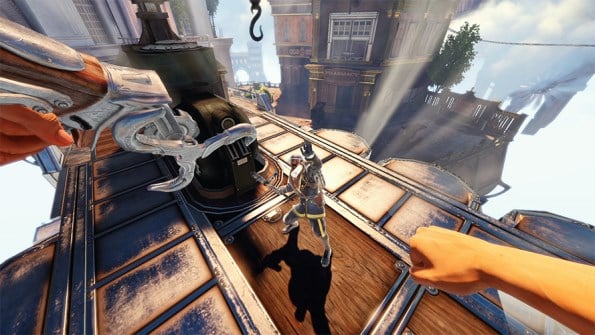Definitive Bioshock Infinite Review with Benchmarks
Gameplay, Plot, and Combat
BioShock Infinite starts as a straightforward mission: Save the girl, and wipe away the debt. It ends somewhere altogether different, and the journey there and back again is one of the best story lines I've ever played. The game is designed to allow plot-centric players to waltz through combat to experience the story, and the story is more than good enough to carry the plot. As is often the case, you'll collect logs that tell you the back story of the characters in question, how the magnificent city of Columbia was built, and what the motivations of its citizenry are.
It's obvious almost immediately that there are enormous tensions between the Vox Populi (under-class) and the ruling citizenry. That tension defines the game and moves it forward; your rescue of Elizabeth precipitates the ignition of the underlying war.
As for the rescue itself, one of the problems with the "Save the girl" game trope is that escort missions typically suck. Games built entirely on escort missions (see: Resident Evil 4) often saddle the hero with a ridiculously fragile counterpart. BioShock Infinite subverts this trope neatly -- almost as soon as you meet her, the game tells you "Elizabeth can take care of herself."
And by and large, she does. While you lose contact with her at a few points, you never have to worry about Elizabeth getting shot, stabbed, or kidnapped if you fail to finish a mission properly. She's a helpmeet and compatriot, not a boat anchor.
Combat:
Combat in BioShock Infinite revolves around the use of firearms and vigors. Vigors, like Plasmids from BioShock 1 & 2, give you specialized combat powers, like the ability to fling fire, lighting, or a murder of crows at your opponents. There are vigors that create a bullet-deflecting shield around you, vigors that yank opponents into melee range (or fling them away), and one vigor that lets you charge an opponent, hitting them hard enough to fuse hydrogen.
There's also a melee attack option, if you enjoy mixing it up close-and-personal. Some of the gear you find will add melee attack capabilities, like a stun chance, while others boost your firearms skills.
At first, this system seems overly simple in an age of cover mechanics and attack combos, but there's far more depth to the system than initially meets the eye. How much fun you have with BI's combat mechanisms depends on how effectively you utilize the game's Skyline system and Elizabeth herself.

It's that moment of dawning, horrified comprehension that makes the game worth playing
Skylines are the series of suspended rails and freight hooks you use to traverse areas of the city. Elizabeth, meanwhile, can summon freight hooks, gun placements, health kits, alternate weapons, and heaps of rubble to serve as cover for Booker as you engage the constabulary of Columbia.
The player therefore has a choice: You can take the straightforward run-and-gun path -- or you can ask Elizabeth to summon a freight hook, use it to line up a melee attack, summon an RPG for yourself, hurl angry crows of death at a pesky guard, induce liquefaction courtesy of the RPG, summon a gun turret at a now-visible choke point, and watch the ensuing carnage.
It's obvious almost immediately that there are enormous tensions between the Vox Populi (under-class) and the ruling citizenry. That tension defines the game and moves it forward; your rescue of Elizabeth precipitates the ignition of the underlying war.
As for the rescue itself, one of the problems with the "Save the girl" game trope is that escort missions typically suck. Games built entirely on escort missions (see: Resident Evil 4) often saddle the hero with a ridiculously fragile counterpart. BioShock Infinite subverts this trope neatly -- almost as soon as you meet her, the game tells you "Elizabeth can take care of herself."
And by and large, she does. While you lose contact with her at a few points, you never have to worry about Elizabeth getting shot, stabbed, or kidnapped if you fail to finish a mission properly. She's a helpmeet and compatriot, not a boat anchor.
Combat:
Combat in BioShock Infinite revolves around the use of firearms and vigors. Vigors, like Plasmids from BioShock 1 & 2, give you specialized combat powers, like the ability to fling fire, lighting, or a murder of crows at your opponents. There are vigors that create a bullet-deflecting shield around you, vigors that yank opponents into melee range (or fling them away), and one vigor that lets you charge an opponent, hitting them hard enough to fuse hydrogen.
There's also a melee attack option, if you enjoy mixing it up close-and-personal. Some of the gear you find will add melee attack capabilities, like a stun chance, while others boost your firearms skills.
At first, this system seems overly simple in an age of cover mechanics and attack combos, but there's far more depth to the system than initially meets the eye. How much fun you have with BI's combat mechanisms depends on how effectively you utilize the game's Skyline system and Elizabeth herself.

It's that moment of dawning, horrified comprehension that makes the game worth playing
Skylines are the series of suspended rails and freight hooks you use to traverse areas of the city. Elizabeth, meanwhile, can summon freight hooks, gun placements, health kits, alternate weapons, and heaps of rubble to serve as cover for Booker as you engage the constabulary of Columbia.
The player therefore has a choice: You can take the straightforward run-and-gun path -- or you can ask Elizabeth to summon a freight hook, use it to line up a melee attack, summon an RPG for yourself, hurl angry crows of death at a pesky guard, induce liquefaction courtesy of the RPG, summon a gun turret at a now-visible choke point, and watch the ensuing carnage.














